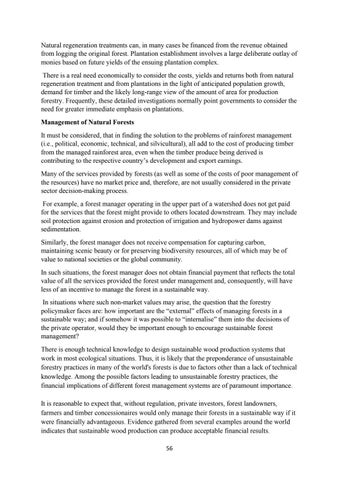Natural regeneration treatments can, in many cases be financed from the revenue obtained from logging the original forest. Plantation establishment involves a large deliberate outlay of monies based on future yields of the ensuing plantation complex. There is a real need economically to consider the costs, yields and returns both from natural regeneration treatment and from plantations in the light of anticipated population growth, demand for timber and the likely long-range view of the amount of area for production forestry. Frequently, these detailed investigations normally point governments to consider the need for greater immediate emphasis on plantations. Management of Natural Forests It must be considered, that in finding the solution to the problems of rainforest management (i.e., political, economic, technical, and silvicultural), all add to the cost of producing timber from the managed rainforest area, even when the timber produce being derived is contributing to the respective country’s development and export earnings. Many of the services provided by forests (as well as some of the costs of poor management of the resources) have no market price and, therefore, are not usually considered in the private sector decision-making process. For example, a forest manager operating in the upper part of a watershed does not get paid for the services that the forest might provide to others located downstream. They may include soil protection against erosion and protection of irrigation and hydropower dams against sedimentation. Similarly, the forest manager does not receive compensation for capturing carbon, maintaining scenic beauty or for preserving biodiversity resources, all of which may be of value to national societies or the global community. In such situations, the forest manager does not obtain financial payment that reflects the total value of all the services provided the forest under management and, consequently, will have less of an incentive to manage the forest in a sustainable way. In situations where such non-market values may arise, the question that the forestry policymaker faces are: how important are the “external” effects of managing forests in a sustainable way; and if somehow it was possible to “internalise” them into the decisions of the private operator, would they be important enough to encourage sustainable forest management? There is enough technical knowledge to design sustainable wood production systems that work in most ecological situations. Thus, it is likely that the preponderance of unsustainable forestry practices in many of the world's forests is due to factors other than a lack of technical knowledge. Among the possible factors leading to unsustainable forestry practices, the financial implications of different forest management systems are of paramount importance. It is reasonable to expect that, without regulation, private investors, forest landowners, farmers and timber concessionaires would only manage their forests in a sustainable way if it were financially advantageous. Evidence gathered from several examples around the world indicates that sustainable wood production can produce acceptable financial results. 56
PNGAF MAGAZINE ISSUE # 9D 2 of 15th October 2021 THE DEVELOPMENT OF PNG'S FOREST MANAGEMENT SYSTEMS

Issuu converts static files into: digital portfolios, online yearbooks, online catalogs, digital photo albums and more. Sign up and create your flipbook.








